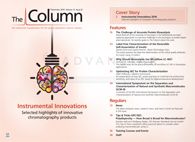Tackling Illegal Insulin Using Dilute and Shoot
Researchers from the Scientific Institute of Public Health, in Brussels, Belgium, have devised a simple dilute and shoot methodology for the identification and quantification of illegal insulin (1).
Photo Credit: Sherry Yates Young/Shutterstock.com

Researchers from the Scientific Institute of Public Health, in Brussels, Belgium, have devised a simple dilute and shoot methodology for the identification and quantification of illegal insulin (1).
The number of individuals diagnosed with diabetes is rising across the globe - in part because of the expanding world population but also the increasingly sugarâheavy diets of many countries. Recent estimations from the World Health Organisation (WHO) suggest as many as 347 million people worldwide suffer from diabetes (2), straining global insulin supplies and creating deficits in some parts of the world (3).
This surplus of demand has in turn created a black market for spurious/falselyâlabelled/falsified/counterfeit (SFFC) insulin, which are not subject to the strict quality controls expected of medicines, leading to incidences of mass hospitalizations and at least one reported death (4,5).
Insulin identification is well documented in the scientific literature, with numerous immunological assays available as well as a diverse range of instrumental analytical methods. However, these all suffer from a wide range of problems - from lengthy sample preparation to concerns about cost. Therefore, the development of a reliable, efficient, cheap, and easily applicable method for illegal insulin identification and quantification was needed.
Researchers developed a simple identification method using liquid chromatography–tandem mass spectrometry coupled to diode array detection (LC–DAD–MS/MS) capable of screening for human insulin, six recombinant insulin analogues, porcine insulin, and bovine insulin.
The fast dilute and shoot methodology developed showed excellent sensitivity without preliminary extensive sample preparation. Successfully distinguishing the various forms of insulin and associated polypeptides. The method is currently being employed at the official medicines control laboratory (OMCL) to analyze insulins retrieved from the illegal market.
References
- C. Vanhee et al., J. Pharma. Anal.6(5), 326–334 (2016).
- WHO Fact sheet N°312 Updated, March 2016, http://www.who.int/mediacentre/factsheets/fs312/en
- G.V. Gill et al., Diabetologia54, 19–24 (2011).
- M.M. Cheng, J. Diabetes Sci. Technol.3,1516–1520 (2009).
- P. Feldschreiber, Clin. Med.9, 63–64 (2009).

New Method Explored for the Detection of CECs in Crops Irrigated with Contaminated Water
April 30th 2025This new study presents a validated QuEChERS–LC-MS/MS method for detecting eight persistent, mobile, and toxic substances in escarole, tomatoes, and tomato leaves irrigated with contaminated water.

.png&w=3840&q=75)

.png&w=3840&q=75)



.png&w=3840&q=75)



.png&w=3840&q=75)












